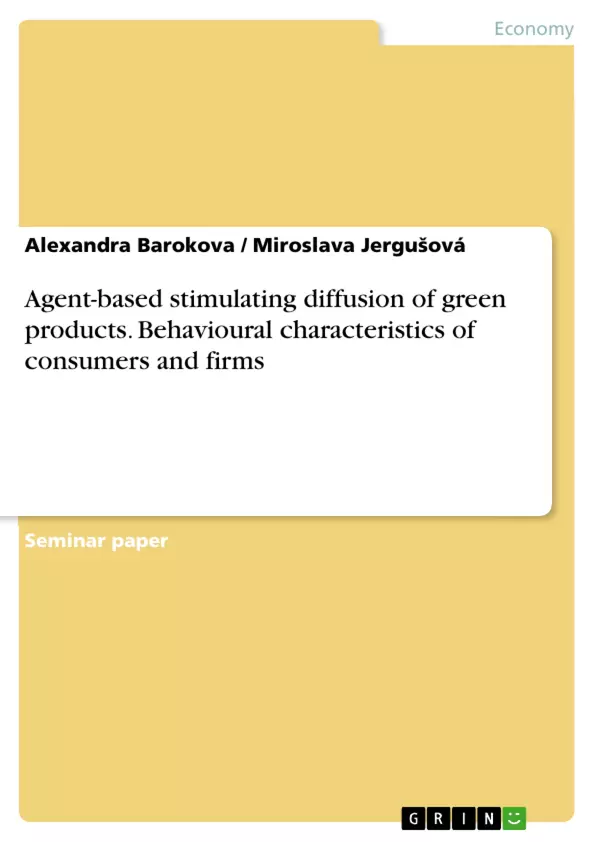The following paper focuses on the agent-based simulation of the diffusion process for green products, i.e. environmentally friendly products that are gaining in importance during the last years. As a basis the article written by Janssen and Jager (2002) is being examined and described in detail. It works with simulating both consumers and firms, whose behavioural characteristics are different and play a significant role in the diffusion process. On the one hand the behavioural characteristics, social processing and status seeking of the consumers and on the other hand the flexibility of firms concerning the adaptation to new technologies is being modelled.
The aim of the study is to show how these behavioural characteristics influence the diffusion process, where the most interesting result has shown that the adaptation of firms to new technologies has a significant impact on group of consumers adapting the green innovation in an early phase. The results also revealed that the diffusion process is faster for deliberate consumers in markets with no adaptability to new technologies than in markets where the adaptation takes place. Moreover the paper also gives an overview about similar studies conducted in the field of agent-based simulations of diffusion processes.
Finally these studies are critically compared with the basic article in order to come up with further research possibilities. These include incorporating the effects of marketing activities and the use of strategies appealing to environmental consciousness on the diffusion process as well as studying the phenomenon of overadoption of an innovation.
Inhaltsverzeichnis (Table of Contents)
- ABSTRACT
- 1. INTRODUCTION
- 2. BACKGROUND
- 2.1. GREEN PRODUCTS
- 2.2. EUROPEAN ENVIRONMENTAL POLICIES AND STATISTICS
- 2.3. TRANSITION FROM INDUSTRIAL TO SERVICE ECONOMY.
- 2.3.1. Consumer behaviour........
- 2.3.2. Lock-in effects..\li>
- 2.3.3. Governmental strategies..\li>
- 2.3.4. Diffusion dynamics
- 3. DESCRIPTION AND OBJECTIVES
- 4. METHODOLOGY APPLIED
- 4.1. AGENT-BASED SIMULATIONS
- 4.2. SENSITIVITY ANALYSIS..........\li>
- 5. THE SIMULATION MODEL OF CO-EVOLVING FIRMS AND CONSUMERS
- 5.1. MODEL STRUCTURE
- 5.1.1. Simulation of firm behaviour (nĚ) ..
- 5.1.2. Simulation of consumer behaviour (nc).
- 6. RESULTS OF THE MODEL EXPERIMENTS
- 6.1. FIXED PRODUCT RANGE
- 6.2. DEVELOPMENT OF PRODUCTS....
- 6.3. SENSITIVITY ANALYSIS.........
- 7. SIMILAR STUDIES…..….…………..\li>
- 7.1. OVERVIEW OF SIMILAR STUDIES
- 7.2. METHODOLOGY USED IN SIMILAR STUDIES......
- 8. CONCLUSION...........
Zielsetzung und Themenschwerpunkte (Objectives and Key Themes)
This paper examines the diffusion process of green products through the lens of agent-based simulations, focusing on the interplay between consumer and firm behavior. The study aims to understand how different behavioral characteristics, including consumer social processing and status seeking, as well as firm flexibility in adapting to new technologies, impact the adoption and spread of green innovations.
- The influence of consumer and firm behavior on the diffusion of green products
- The role of social networks, lock-in effects, and diffusion dynamics in consumer adoption
- The impact of firm adaptability to new technologies on green product adoption
- Comparison of the study's methodology with similar studies in the field of agent-based simulations
- Exploration of further research possibilities, including the effects of marketing and environmental consciousness on diffusion
Zusammenfassung der Kapitel (Chapter Summaries)
- Introduction: This chapter introduces the topic of green products and their importance in transitioning towards a more sustainable economy. The paper focuses on the model-based analysis of green product introduction, highlighting the contrasting behavioral characteristics of firms and consumers that influence their willingness to switch to green consumption.
- Background: This chapter provides context for the study, covering concepts such as green products, European environmental policies, and the transition from an industrial to a service economy. It delves into consumer behavior, including social networks, lock-in effects, and governmental strategies, which are important factors in the diffusion process.
- Methodology Applied: This chapter explains the methodology used in the study, specifically agent-based simulations and sensitivity analysis. Agent-based simulations are employed to model the interactions between firms and consumers, while sensitivity analysis helps assess the influence of different factors on the diffusion process.
- The Simulation Model of Co-Evolving Firms and Consumers: This chapter details the structure of the simulation model, including the simulation of both firm and consumer behavior. It explores how the model captures the dynamic interplay between these two groups, considering aspects such as firm flexibility in adapting to new technologies and consumer social processing and status seeking.
- Results of the Model Experiments: This chapter presents the results of the model experiments, examining different scenarios such as fixed product ranges and product development. It analyzes the impact of different factors on the diffusion of green products, such as firm adaptability to new technologies and consumer characteristics.
- Similar Studies: This chapter provides an overview of similar studies conducted in the field of agent-based simulations of diffusion processes. It compares the methodology used in these studies with that of the current paper, offering critical analysis and identifying potential areas for future research.
Schlüsselwörter (Keywords)
The study focuses on green products, agent-based simulations, diffusion process, consumer behavior, firm behavior, adaptability to new technologies, social networks, lock-in effects, diffusion dynamics, environmental policies, sustainability, and innovation.
- Arbeit zitieren
- Alexandra Barokova (Autor:in), Miroslava Jergušová (Autor:in), 2013, Agent-based stimulating diffusion of green products. Behavioural characteristics of consumers and firms, München, GRIN Verlag, https://www.grin.com/document/340146



